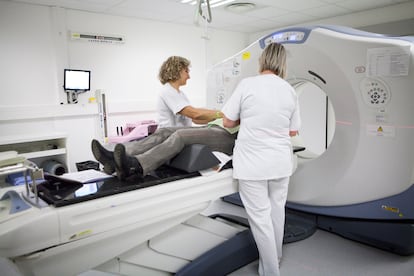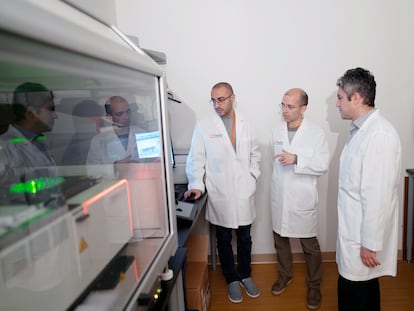New era of medicine breaks through against the most aggressive lung cancer
A pharmaceutical that links lymphocytes with malignant cells to destroy them reinforces the role of immunotherapy in small cell tumors

The small cell (or microcytic) tumor is a lung cancer that grows furiously, quickly and very aggressively. It is a disease that spreads vertiginously and, by the time it shows its face, is usually quite advanced, with metastasis in other organs and accompanied by a very unfavorable prognosis. For decades, doctors have puzzled over how to treat this kind of cancer, with few tools apart from chemotherapy, which is useful for dealing the first blow but less so if the cancer reappeared. However, this journey through the treatment desert appears to be at an end. Step by step, and with steady if modest results, a new generation of drugs has begun to point towards ways to combat the nefarious tumor.
Oncologists aren’t claiming victory just yet, but many say that a new constellation of treatments for small cell lung cancer invites optimism. Particularly given the severity of the condition. In 70% of times the tumors are detected, they are already in very advanced stages. Five-year survival rates are below 5%. Given this context, and after decades of convincing positive results from new experimental drugs, the first immunotherapy of this new wave, which debuted five years ago to a modest success rate, generated a high level of interest. Since then, trials of new pharmaceutical combinations, studies of promising molecules and, in particular, the arrival of a new medication that links lymphocytes to tumor cells to destroy them, has raised new hope for improving survival rates when it comes to these complex tumors.
Throughout 2024, 33,000 lung cancer cases will be diagnosed in Spain, according to figures released by the Spanish Society of Clinical Oncology. Of these, around 15% will be microcytic, a tumor closely linked to tobacco and common among heavy smokers. “It is the most aggressive tumor, with a very high capacity for proliferation. It is usually diagnosed in advanced stages and can metastasize in the liver or brain. In addition, when it appears, the patient can be very symptomatic. It is a tumor that can push patients to their limits,” says Ernest Nadal, director of the thoracic tumor program at the Catalan Institute of Oncology.
In this context, treatment options are limited. As it is often detected late, the chances of operating to remove the tumor is “anecdotal,” says Luis Paz-Ares, head of clinical oncology at the Hospital 12 de Octubre in Madrid. Chemo and radiotherapy are the most common approaches, but they are far from infallible: “The prognosis is poor because, despite being sensitive to chemotherapy and radiotherapy, sensitivity is short-lived and the tumor become resistant,” says Paz-Ares.
There have been attempts to incorporate innovative strategies to cure other types of lung cancer, searches for apt molecular targets and formulas geared towards reactivating the immune system, but these have not borne fruit. The behavior and surrounding environment of the tumor cells present certain difficulties, explains Paz-Ares: “There are no targets for treatment. There are no aberrations or alterations in the oncogenes where the disease starts. Also, it has a very immunosuppressive immunological context and immunotherapy tends to be less effective.”
An orphan disease
As a product of tobacco, the tumor may feature many mutations, but scientists have been unable to use these to locate the genes that are key to the proliferation of this type of cancer. If that weren’t enough, its tumor cells have the capacity to evade the immune system: they camouflage to avoid lymphocytes, which form part of the body’s defenses, being able to recognize and kill them. “The primary strategy is chemotherapy. If nothing is done, you can lose the patient in a matter of weeks. There are few chances of long-term survival. Because of this, it’s like an orphan disease, and any advancement is a source of hope,” says Nadal.
The glimmer of a solution arrived five years ago with the appearance of the first immunotherapies in combination with traditional chemotherapy. This constituted, in the words of Margarita Majem, oncologist at Barcelona’s Sant Pau Hospital, “a small improvement,” but nothing comparable to the impact immunotherapy has had on non-small cell lung cancer and other types of tumors. Paz-Ares agrees: “It benefits a little. Survival at three or five years has gone from 2% to 5% up to 12% to 15%.” The increase in survival rates may have been modest, but it represented a break with the slow progress that had taken place over the preceding 30 years, when 60 molecules tested in 40 trials all produced negligible results.
After this turning point, other therapeutic approaches have appeared that are proving to be increasingly effective in combating the complicated tumors. Last year, a phase II study was presented with a new drug, Tarlatamab, an antibody that works as an intermediary, bringing lymphocytes into contact with tumor cells so that these bodily defenses can recognize and annihilate them. “We are beginning to understand how we can intervene in the immunological context, and that is what has happened with Tarlatamab,” says Paz-Ares, lead author of the research. The molecule is a bispecific antibody with two arms: one binds to the lymphocyte and the other sticks to a protein present on the membrane of tumor cells, and presents them to the immune system in order to identify and kill the malignant cells.
According to the study’s results, tumors were shrunk in 40% of patients. The median survival rate rose above 14 months. “With more follow-up, we are seeing that the median survival rate rises above 18 months. We speculate that there will be an impact on survival,” says Paz-Ares. The FDA has already approved the treatment.
Cautious optimism
At the moment, Tarlatamab is the most promising treatment, but it is not free of risks. There can be side effects, like neurotoxicity (confusion, changes in behavior) or cytokine release syndrome, which is the most worrying, and refers to when the immune system is stimulated and lymphocytes begin to release substances, such as cytokines, and generate a kind of systemic inflammation which, if not treated in time, can lead to multi-organ failure and death. Paz-Ares explains that the cytokine storm occurred in 50% of cases, but less than 5% were severe.
Enriqueta Felip, head of thoracic tumors and cancers of the head and neck at Barcelona’s Vall d’Hebron Hospital Institute of Oncology (VHIO) says that, given what we know of it, Tarlatamab is “a relevant drug.” “Its toxicity, which worried us at first, is manageable. We see lasting results and that is very relevant in this situation,” she says. Majem agrees, but calls for prudence: “It’s been seen to work well and that opens a door for us in terms of hope for new treatments, but we are still learning which patients, exactly, will benefit most.”
At the last meeting of the American Society of Clinical Oncology (ASCO), which took place last week in Chicago, a phase I/II study was also presented that features a new combination of chemotherapies: Lurbinectedin with Irinotecan, which showed “promising antitumor activity.” “It is a combination that, in preclinical studies, has been shown to be very effective and we have confirmed very significant remission rates in pretreated patients. In this study, which features a large number of patients, survival rates are in an appreciable range for its clinical context,” says Paz-Ares, who oversaw the research that was presented at the meeting.
Majem says that these response rates are “very interesting.” Above all, among patients who are especially sensitive to chemotherapy. “This combo presents promising results, and the toxicity profile comes from the chemotherapy, known risks that we know how to manage,” she says. Patients are already being recruited to confirm these findings in a phase III study.
Changing expectations
Although the majority of patients are diagnosed in an advanced stage, around 25% of patients are diagnosed with a localized tumor. Among these cases, prognosis is initially more favorable, but new therapeutic approaches are being investigated to improve survival rates. “Each year, we diagnose 60 cases of small-cell lung cancer and of these, 10 to 12 are localized. There is some hope there: the combination of chemotherapy with radiotherapy can cure a small fraction (around 20% to 25%), although the majority very often end up relapsing later with metastases. There is now a study that is trying immunotherapy after chemo and radiotherapy,” says Nadal.
He is referring to the Adriatic study, which tests the benefit of adding to standard treatment Durvalumab, a type of immunotherapy that reactivates immune cells so that they attack the tumor. “If results are positive, there will be a change in clinical practice,” says Felip. Preliminary data presented at ASCO pointed to a median survival rate after Durvalumab as consolidation therapy for localized tumors was 56 months, compared with a median of 33 months among patients who had received a placebo. “The data is encouraging,” says Nadal.
With all this new therapeutic arsenal in the making, the long journey through the desert does appear to be nearing its end. Neither the new immunotherapies nor the new drug combinations “will be a cure,” warns Majem, but they are steps forward that “improve survival.” Nadal agrees: “We are beginning to see, taking into account the seriousness of the disease and modest results, that there is a change in the level of expectations we can have. But we must not be satisfied, we must continue.”
Sign up for our weekly newsletter to get more English-language news coverage from EL PAÍS USA Edition
Tu suscripción se está usando en otro dispositivo
¿Quieres añadir otro usuario a tu suscripción?
Si continúas leyendo en este dispositivo, no se podrá leer en el otro.
FlechaTu suscripción se está usando en otro dispositivo y solo puedes acceder a EL PAÍS desde un dispositivo a la vez.
Si quieres compartir tu cuenta, cambia tu suscripción a la modalidad Premium, así podrás añadir otro usuario. Cada uno accederá con su propia cuenta de email, lo que os permitirá personalizar vuestra experiencia en EL PAÍS.
¿Tienes una suscripción de empresa? Accede aquí para contratar más cuentas.
En el caso de no saber quién está usando tu cuenta, te recomendamos cambiar tu contraseña aquí.
Si decides continuar compartiendo tu cuenta, este mensaje se mostrará en tu dispositivo y en el de la otra persona que está usando tu cuenta de forma indefinida, afectando a tu experiencia de lectura. Puedes consultar aquí los términos y condiciones de la suscripción digital.











































